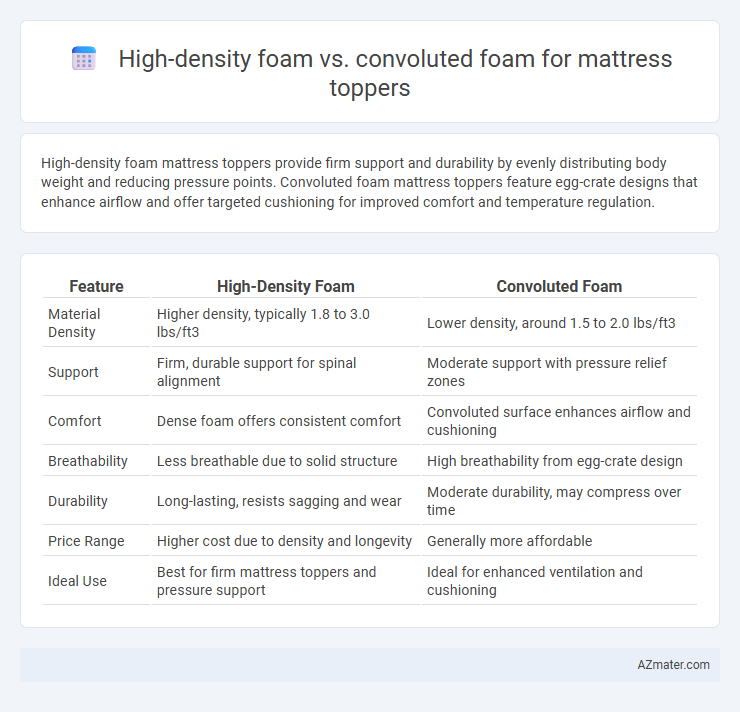High-density foam mattress toppers provide firm support and durability by evenly distributing body weight and reducing pressure points. Convoluted foam mattress toppers feature egg-crate designs that enhance airflow and offer targeted cushioning for improved comfort and temperature regulation.
Table of Comparison
| Feature | High-Density Foam | Convoluted Foam |
|---|---|---|
| Material Density | Higher density, typically 1.8 to 3.0 lbs/ft3 | Lower density, around 1.5 to 2.0 lbs/ft3 |
| Support | Firm, durable support for spinal alignment | Moderate support with pressure relief zones |
| Comfort | Dense foam offers consistent comfort | Convoluted surface enhances airflow and cushioning |
| Breathability | Less breathable due to solid structure | High breathability from egg-crate design |
| Durability | Long-lasting, resists sagging and wear | Moderate durability, may compress over time |
| Price Range | Higher cost due to density and longevity | Generally more affordable |
| Ideal Use | Best for firm mattress toppers and pressure support | Ideal for enhanced ventilation and cushioning |
Introduction to Mattress Topper Materials
High-density foam and convoluted foam are popular materials for mattress toppers, each offering unique support characteristics. High-density foam provides firm, consistent support and durability by evenly distributing body weight, ideal for pressure relief and spinal alignment. Convoluted foam features an egg-crate design that enhances airflow and increases cushioning, making it effective for temperature regulation and added comfort.
What is High-Density Foam?
High-density foam is a type of polyurethane foam characterized by its greater weight and durability, typically measured at densities above 5 pounds per cubic foot. This foam offers superior support and longevity compared to convoluted foam, making it ideal for mattress toppers aimed at pressure relief and spinal alignment. Its dense cellular structure provides consistent firmness and enhanced resistance to sagging over time, supporting better sleep quality.
Understanding Convoluted Foam (Egg Crate Foam)
Convoluted foam, often known as egg crate foam, features a distinctive egg crate pattern that enhances airflow and improves breathability, making it ideal for mattress toppers aimed at temperature regulation. This open-cell structure helps distribute body weight evenly, reducing pressure points and offering targeted support combined with a softer feel compared to high-density foam. While high-density foam provides firm, durable support and longevity, convoluted foam excels in comfort and ventilation, especially for sleepers seeking cooler, pressure-relieving sleep surfaces.
Comfort and Support Comparison
High-density foam offers superior support by maintaining consistent firmness and effectively distributing body weight, reducing pressure points for enhanced spinal alignment. Convoluted foam provides increased airflow and cushioning through its egg-crate design, promoting comfort with a softer, contouring feel that adapts to body curves. When comparing comfort and support, high-density foam excels in durability and support for back pain relief, while convoluted foam prioritizes breathability and gentle pressure relief.
Durability and Longevity Analysis
High-density foam mattress toppers provide superior durability due to their compact cell structure, resisting sagging and maintaining support over extended periods. Convoluted foam, designed with peaks and valleys for enhanced airflow, tends to compress faster under continuous use, reducing its longevity compared to high-density foam. Studies indicate that high-density foam can last up to 10 years, whereas convoluted foam usually requires replacement within 3 to 5 years due to quicker material breakdown.
Breathability and Temperature Regulation
High-density foam offers excellent support but tends to retain heat due to its dense structure, limiting breathability and temperature regulation. Convoluted foam features an egg-crate design that promotes better airflow and enhances heat dissipation, improving breathability and maintaining a cooler sleeping surface. For optimal temperature regulation, convoluted foam is often preferred over high-density foam in mattress toppers.
Allergy Concerns and Health Implications
High-density foam mattress toppers offer dense, hypoallergenic properties that resist dust mites and mold, making them ideal for allergy sufferers seeking a clean sleep environment. Convoluted foam features an egg-crate design that promotes airflow and reduces heat retention but may trap allergens if not properly maintained. Choosing high-density foam can minimize exposure to common allergens, thereby enhancing respiratory health and reducing allergy-related symptoms.
Price and Value Considerations
High-density foam mattress toppers generally offer superior durability and support compared to convoluted foam, commanding a higher price due to their dense material and longer lifespan. Convoluted foam tends to be more affordable and provides enhanced airflow and pressure relief, though it may compress faster and require more frequent replacement. When evaluating price and value, investing in high-density foam often yields better long-term support and cost efficiency, while convoluted foam suits budget-conscious consumers seeking immediate comfort.
Who Should Choose High-Density Foam?
High-density foam mattress toppers provide firm support and excellent durability, making them ideal for individuals with chronic back pain or those who require enhanced spinal alignment during sleep. Athletes or heavy sleepers benefit from the density's ability to absorb impact and reduce pressure points, promoting better recovery and comfort. People who prefer a solid, stable surface over a softer, contouring feel should choose high-density foam for long-lasting support.
Who Should Opt for Convoluted Foam?
Convoluted foam mattress toppers are ideal for individuals seeking enhanced airflow and pressure relief, particularly those who tend to sleep hot or need targeted support for pressure points. Athletes and people with joint pain benefit from its contoured design, which improves ventilation and comfort by reducing heat buildup. Those prioritizing a cooler sleep environment and contouring support without the firmness of high-density foam should opt for convoluted foam toppers.

Infographic: High-density foam vs Convoluted foam for Mattress topper
 azmater.com
azmater.com